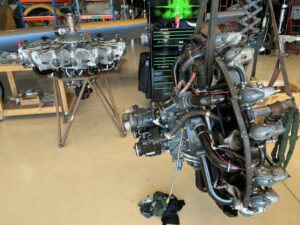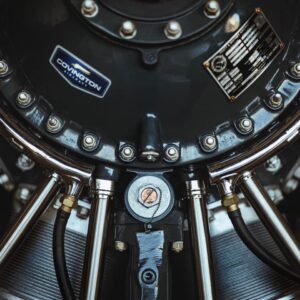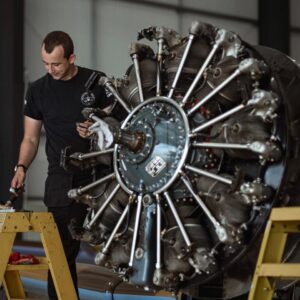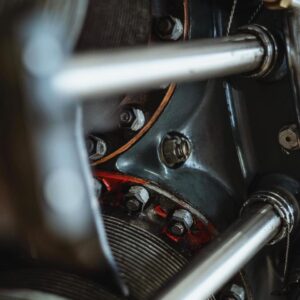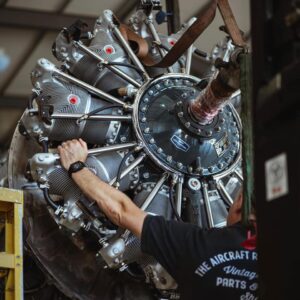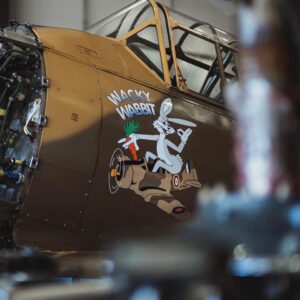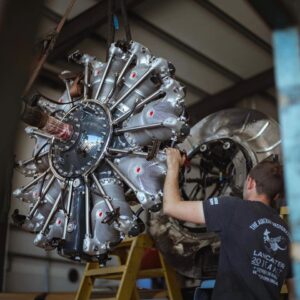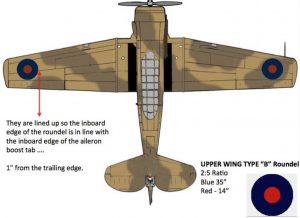The HISTORY of – G-BJST CC&F-4-292 – HARVARD 4
Below is the complete history of the Harvard 4 G-BJST in chronological order – As major improvements are made to the aircraft I shall also log them on this page so please enjoy the journey:
 Harvard G-BJST was built in 1953 by the Canadian Car and Foundry Company (C&CF) as a Harvard 4. It was built for the USAF under the Mutual Development Assistance Program (MDAP) due to Military officials calling to introduce legislation to expand suitable military training equipment. After the negotiation of the North Atlantic defence treaty, there was a requirement to provide military aid to strengthen member country’s against the communist threat in Europe. As part of an order placed in 1951 by the USAF, aircraft were supplied to the French, German, Italian, Turkish, and other Airforce’s to help speed up their recovery after world war two. Apparently, under contract number AF-20641, two batches of Harvards were manufactured by the CCF. The first batch consisted of 143 aircraft, with 69 going to Italy, 24 to Belgium, and 51 to the French Air Force
Harvard G-BJST was built in 1953 by the Canadian Car and Foundry Company (C&CF) as a Harvard 4. It was built for the USAF under the Mutual Development Assistance Program (MDAP) due to Military officials calling to introduce legislation to expand suitable military training equipment. After the negotiation of the North Atlantic defence treaty, there was a requirement to provide military aid to strengthen member country’s against the communist threat in Europe. As part of an order placed in 1951 by the USAF, aircraft were supplied to the French, German, Italian, Turkish, and other Airforce’s to help speed up their recovery after world war two. Apparently, under contract number AF-20641, two batches of Harvards were manufactured by the CCF. The first batch consisted of 143 aircraft, with 69 going to Italy, 24 to Belgium, and 51 to the French Air Force
1953 – Constructed as a Harvard 4 by Canadian Car and Foundry at Fort William (Thunder Bay), Ontario, Can.
Built as part of the Mutual Development Assistance Program (MDAP)
Taken on Strength/Charge with the United States Air Force with s/n 51-17110.
S/n issued for administrative purpose only – did not serve with the USAF.
 Pictured right – we have Harvard 4 MM53795 in Italian service, which later became G-BJST (Picture submitted by Martin Pengelly)
Pictured right – we have Harvard 4 MM53795 in Italian service, which later became G-BJST (Picture submitted by Martin Pengelly)
1953 – Taken on Strength/Charge with the Aeronautica Militare Italiana with s/n MM53795. Transferred to SCIV (IA Scuola Centrale di Volo) (Central School of Flight Instructors). Markings Applied: SC-66
1981 – From 21 December 1981 to 26 July 1994 To Victor Samuel Eric Norman, Gloucs with c/r G-BJST.
1981 – From 21 December 1981 to 26 July, 1994 Painted as a Zero for the film Empire of the Sun.
1996 – From 5 November 1996 to 2 January 1998 To Gerhard Robert Adolf Schilling.
1998 – From 2 January 1998 to 31 August 2000 To Anette Schilling.
2000 – From 31 August 2000 to 30 November 2004 To Tuplin Holdings Ltd.
2004 – From 30 November 2004 to 24 February 2005 To Classic Aero Engineering Ltd.
2005 – From 24 February 2005 to 11 August 2009 To Peter John Tuplin.
2005 – By September 2005, Markings Applied: KF729 – Royal Air Force marks worn. Painted in the colour scheme of the aircraft, HRH Prince Philip flew during his advanced training. His Harvard at that time bore the five stars denoting his rank of Marshal of the Royal Air Force.
2009 – From 11 August 2009 to 22 July 2010 To Classic Aero Engineering Ltd UK.
2010 – From 22 July 2010 to 15 July 2014 To Neil Thomas Oakman.
2013 – Based at Duxford Airport, Duxford, Cambridgeshire/Cambs, England.
2013 – Operates with T6 Harvard Aviation Ltd for pleasure flights
2014 – 15 July 2014 To Glenister John Fricker and partners
2020 – 1st October 2020 – Sold to Andrew Goodall, Brian Jones Trustees T6 Harvard Ltd
Below is the history of G-BJST
1953 – 1970’S MM53799 AT LATINA, THE SISTER AIRCRAFT TO G-BJST
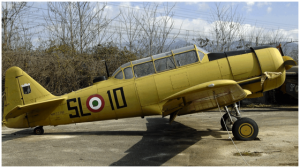
DESIGNATED AS MM53795
After production in January 1953, the USAF serial number 51-17110 with its original airframe number of CCF4-292 and sent in a consignment of 69 to Belfast, Northern Ireland, where they were reassembled and later flown to Italy. When the Italian air force received their new aircraft, they gave it their own serial number of MM53795. It was sent to the Italian air force to provide training for their new emerging Airforce and was probably based at Latina airbase near Rome, where its sister aircraft now stands as a gate guardian.
1970’S – G-BJST DURING HER TIME WITH THE ITALIAN AIR FORCE

FINAL POSTING
During the 1970’s it finished its service with the Italian Airforce ending its service life as a SCIV (Ia Scuola Centrale di Volo (Central school of flight instructors). Its history becomes a bit sketchy. However, it appeared in the UK and on to the British register in December 1981 at Kemble, where the photograph on the right was taken. Thanks to Martin Pole for sourcing the Photograph and above information.
1980’S – G-BJST THEN REAPPEARED IN COVENTRY, ENGLAND, AT VICTOR AVIATION AROUND 1986/87

REAPPEARANCE DURING THE 80S
Apparently, at this time, G-BJST was part of the Jeff Hawks collection that supplied aircraft to the film industry) and was painted to appear as a Japanese Zero in “Empire of the Sun”, with some work carried out to the rear canopy to make it look more authentic. Its masquerade as a Zero was a little more convincing involving surgery to the canopy area + wing mods. It was shrouded in transparent plastic, G-BJST when offered for sale in an auction at Luton. You can see two of the Nord 3400s in the background. Ironically these also came originally from Ferte Alais.
With kind permission – Words and pictures by Tim Badham from an article on The Aviation Forum – http://forum.keypublishing.com/showthread.php?51235-G-TOMC-when-at-Baginton&highlight=G-BJST – G-BJST apparently withdrawn from the auction due to missing paperwork! CCF 292 Changed ownership again in 1996 and was taken to Little Gransdon for restoration to flying condition; this was a slow process and eventually sold in August 2000 to Peter Tuplin at Classic Aero Ltd. (Photo Martin Pole)
2000 THE NEW COLOURS APPLIED – THE ROYAL CONNECTION 1953

ROYAL CONNECTION
G-BJST was painted in the colour scheme of the aircraft HRH Prince Philip flew during his advanced training. His Harvard at that time bore the five stars denoting his rank of Marshal of the Royal Air Force and is accurately represented on the starboard side of the aircraft today.
BBC NEWS REPORT – 1953: Duke of Edinburgh gets his wings. Edinburgh’s Duke has been awarded his pilot’s “wings” during a private ceremony at Buckingham Palace. He was presented with the award by Air Chief Marshall Sir William Dickson, Chief of Air Staff.
 The Duke’s flying instructor, 29-year-old Flight-Lieutenant Caryl Ramsay Gordon, was present at the ceremony. He watched his royal pupil complete three solo circuits and landings earlier in the day, or “bumps”, as they are called, at White Waltham airfield in Berkshire to qualify for his wings.
The Duke’s flying instructor, 29-year-old Flight-Lieutenant Caryl Ramsay Gordon, was present at the ceremony. He watched his royal pupil complete three solo circuits and landings earlier in the day, or “bumps”, as they are called, at White Waltham airfield in Berkshire to qualify for his wings.
An RAF examining unit had described his flying as “thoughtful with a sense of safety and airmanship above average”.
ENTER “THE WACKY WABBIT” AJ841
G-BJST Wacky Wabbit – A decision was made by the T6 Harvard syndicate in August 2014 to repaint G-BJST in a new colour scheme for 2015 as the current paint was looking rather tired. The idea to paint her as a former RAF Desert Air Force (DAF) MKII Harvard was suggested by Andy to the group, and it was agreed. However, the question was, who is going to pay for it? Andy put out the feelers for a sponsor, and that’s when talks began with Richard Pike and Sam Woodgate of RS Paintworks based at Fishburn airfield. (Now at Eshott airfield Northumberland as of 2016) As a start-up enterprise, they looked at Harvard as a flagship project to launchpad their business. Eshott Airfield link
They had an airfield, a new dedicated spray booth with all the mod cons, brand new equipment, and, more importantly, a painter/engineer that had been in the business for over 30 years. A deal was set up over a phone call and a few Facebook messages, and RS paintworks became our first official sponsor. I want to thank RS for their kind generosity by taking on this project and offering sponsorship. They have a bright future in aviation, and we wish them all the best.
RS PAINTWORKS FISHBURN AIRFIELD (Now based at Eshott Airfield in Northumberland)
Before restoration even began, painstaking research had to be done to find the right Harvard that was in the right place at the right time. We wanted to find a Harvard that served with the RAF in the DAF with a Duxford link. Martin Pengelly found AJ841 flying with a former Fowlmere squadron, a stone’s throw from Duxford just to the West. Having acquired the Air Ministry form 78 and permission from the RAF to replicate the original markings, we started to research the original colours and markings applied to Harvard’s in theatre at that time. As with many wartime aircraft, there were many camouflage colours, roundels styles, and sizes. After much research, thanks to Shane Clayton’s help in Canada, we settled on the patterns below. We didn’t just want to get it close to the original; we wanted to get it right! Although we are using a Harvard 4 as the base aircraft, we changed the canopy to a Harvard II just for the added authenticity. Unfortunately, when writing this in May 2015, there is no Harvard in the UK representing a DAF Harvard or, indeed, in Europe. The only accurate Harvard in original DAF colours is ‘AJ845’ (VH-TXN), FS966, based in Australia.
Why the Wacky Wabbit squadron patch as nose art?

Why the “Wacky Wabbit”? – T6 Harvard Ltd added the logo purely for marketing purposes. Andrew Goodall found the design on the internet on a WW2 patch that was for sale on eBay. Andrew decided to use the design and colour in the yellow Harvard with British Desert Camouflage. We knew nothing about this badge other than a cool design and would look nice on the aircraft. By pure chance, Andrew was contacted by Chris Applegarth, whose father was in 5 BFTS in 1945 and had the original design! Unbelievable coincidence!
The patch to the right and below – This is also an original patch from 1945 showing a slightly different coloured background; variations were always common.

Provenance – Good evening, Andrew. Sorry for the delay getting back. The details of the badge were in some of my dad’s old documents. He had a tracing of one. Subsequently, I met several 5 BFTS students who also had their own. 5 BFTS painted them on leather-like yours. – Chris Applegarth
 The design to the right – Andrew Goodall slightly modified the design further and gave it the name “Wacky Wabbit”, which he wanted to call “Wicked Wabbit”; however, a famous P47 Thunderbolt took that! Nevertheless, the kids love it, and it gives this beautiful Harvard an identity. Andrew comments that he also has to give Richard and Sam of Eshott Airfield credit for helping choose the name and convincing him to add it to both sides of the Aircraft. And so the Wacky Wabbit was born!
The design to the right – Andrew Goodall slightly modified the design further and gave it the name “Wacky Wabbit”, which he wanted to call “Wicked Wabbit”; however, a famous P47 Thunderbolt took that! Nevertheless, the kids love it, and it gives this beautiful Harvard an identity. Andrew comments that he also has to give Richard and Sam of Eshott Airfield credit for helping choose the name and convincing him to add it to both sides of the Aircraft. And so the Wacky Wabbit was born!
Original squadron patch 5 BFTS
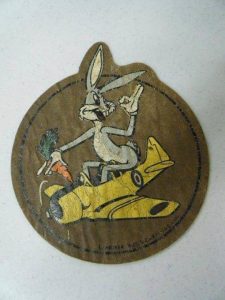 About No 5 BFTS – 1940, and the world was at war. Europe and Scandinavia had fallen. Britain stood alone against Nazi Germany. Air Chief Marshal Sir Charles Portal had already decided that the RAF should abandon flying training in the United Kingdom RAF in war. “It would be fraught with problems and danger. The British Isles were cramped, vulnerable, and subject to bad weather.” Imagine instructing cadets in Tiger Moths in the hostile skies of Britain! So RAF training had to be relocated to secure a constant supply of pilots to defend our Realm. The wisdom behind this was highlighted on 16 August 1940 when the Luftwaffe, in a single attack on RAF Brize Norton, destroyed 46 training aircraft.
About No 5 BFTS – 1940, and the world was at war. Europe and Scandinavia had fallen. Britain stood alone against Nazi Germany. Air Chief Marshal Sir Charles Portal had already decided that the RAF should abandon flying training in the United Kingdom RAF in war. “It would be fraught with problems and danger. The British Isles were cramped, vulnerable, and subject to bad weather.” Imagine instructing cadets in Tiger Moths in the hostile skies of Britain! So RAF training had to be relocated to secure a constant supply of pilots to defend our Realm. The wisdom behind this was highlighted on 16 August 1940 when the Luftwaffe, in a single attack on RAF Brize Norton, destroyed 46 training aircraft.
 General “Hap” Arnold, Chief of the US Army Air Corps, supported Britain, and largely due to his efforts, flying training began in the USA in early 1941. The Arnold Scheme operational 1941-1943 and the BFTSs operational 1941-1945.
General “Hap” Arnold, Chief of the US Army Air Corps, supported Britain, and largely due to his efforts, flying training began in the USA in early 1941. The Arnold Scheme operational 1941-1943 and the BFTSs operational 1941-1945.
The Patch to the right is our modern interpretation of the original patch from 5 BFTS. As you can see, it looks well worn, and that’s because it has over 400 hours in G-BJST as the “Wacky Wabbit.”
DAF HARVARD – FINDING EVIDENCE OF ORIGINAL DESSERT HARVARDS
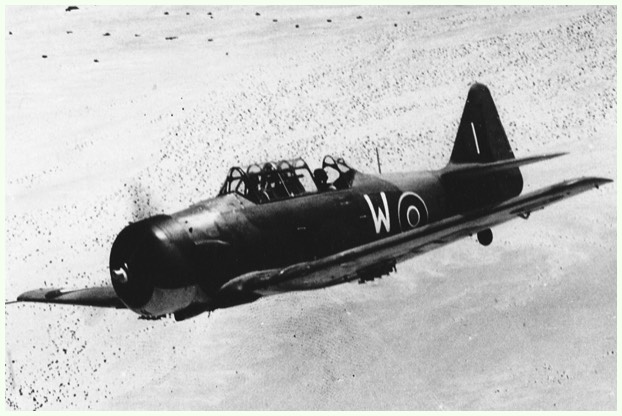
Left – An original DAF Harvard, this has a slight variation on the fuselage roundels, different to the roundels used on AJ844 AJ845 and AJ841 … It also has bomb racks, so I guess this was used as a bombing trainer in the desert as there are no accounts of a DAF Harvard; taking part in any action in this theatre of ops. Just another pic adding to the many variations that pilots saw during WW2. The Wabbit would look great with bomb racks, right?
Roundels
Research – Many research went into getting the correct roundels in the right place and the right size. We had less than 10 original pictures of DAF Harvards on operations in the desert between 1941 and 1945, and there was some variation; however, we settled on the below scheme, which fitted into the general theme, and we believe that this would be an accurate representation of AJ841 when it was in war service with the DAF.
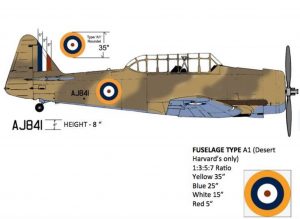
REPRESENTATION OF AJ841 HARVARD II DESERT AIR FORCE 1941-46
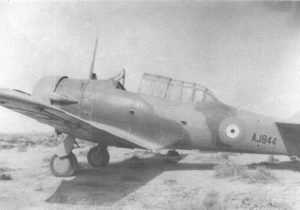
Harvard AJ841 – AJ841 was shipped directly from the USA to the Middle East on the 23rd November 1941 on the steamship M Livanos, and she was struck off charge on the 25th April 1946.
During her time in the Middle East, AJ841 saw service with 74 OTU, where it is believed she would have been used for acclimatising fighter and army cooperation pilots to desert conditions. However, records show that The RAF also used Harvard’s in this area for conversion and continuation training for pilots on to the Hurricane and Spitfire.
74 OTU formed in Aqir in Palestine from ‘C’ Flight of 71 OTU who made various moves to Rayak in July 1942, Muqeibila in November 1942, and back to Aqir in February 1943. The RAF later handed over control to 203 Group in May 1943. The unit disbanded in July 1945.
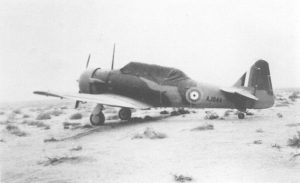 Harvard AJ841 – AJ 841 does have a connection with Duxford as she saw service with 154 Squadron. Originally 154 Squadron were based just to the West of RAF Duxford at RAF Fowlmere before deploying to the Middle East in 1942. Record cards for 154 Squadron show the squadron Harvard being flown by flying officer DC Dunn from Minnigh (Syria) to Ramat David (Palestine) on the 12th February 1944.
Harvard AJ841 – AJ 841 does have a connection with Duxford as she saw service with 154 Squadron. Originally 154 Squadron were based just to the West of RAF Duxford at RAF Fowlmere before deploying to the Middle East in 1942. Record cards for 154 Squadron show the squadron Harvard being flown by flying officer DC Dunn from Minnigh (Syria) to Ramat David (Palestine) on the 12th February 1944.
An excerpt from the 154 Squadron Diary 11th February 1944:
 154 Squadron DAF – Arrived. We lived under very uncomfortable conditions owing to having been separated from our kit. As airlift for pilots could not be arranged, the RAF had sent them with the ground party.
154 Squadron DAF – Arrived. We lived under very uncomfortable conditions owing to having been separated from our kit. As airlift for pilots could not be arranged, the RAF had sent them with the ground party.
We were, first of all, told that we were going to Italy, but this was afterwards altered to Corsica. A few days after our arrival, we were informed the ‘wing’ would be converted to Spitfire IXs. (Photo reenactment 2016 Eshott Airfield) History of G-BJST by Martin Pengelly
It seems that it wasn’t just 154 squadron and 74 OTU that used Harvard AJ841; new evidence came to light when Joe Hirst of the Biggin Hill Heritage Hangar found a logbook, a former Spitfire pilot. When he opened the book, he immediately saw Harvard AJ841 logged. This was like finding a needle in a Haystack!
243 Squadron 11th January 1944 – AJ841 logged
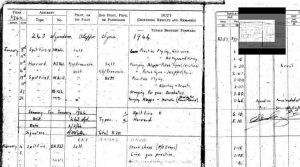 AJ841 – AJ841 was logged on the 11th January 1944 flying from “Syria” Allepo to Petah Tiger in Palestine with the pilot named as F/Sgt Ernewein and passenger marked as ‘Self” The return journey was made from Palestine back to Aleppo on the 16th January 1944 this time with the pilot “Self” and the passenger F/Sgt Ernewein. The logbook is marked on this page as “243 Squadron Allepo Syria 1944.”
AJ841 – AJ841 was logged on the 11th January 1944 flying from “Syria” Allepo to Petah Tiger in Palestine with the pilot named as F/Sgt Ernewein and passenger marked as ‘Self” The return journey was made from Palestine back to Aleppo on the 16th January 1944 this time with the pilot “Self” and the passenger F/Sgt Ernewein. The logbook is marked on this page as “243 Squadron Allepo Syria 1944.”
243 squadron were in the following locations around this time – December 1943: Kabrit, December 1943-January 1944: Aleppo, January-April 1944: Ramat David, April 1944: Alto
AJ 841 diary of restoration
The chronology of the restoration is a small diary of events as we go through the repaint. I aim to log and record all the work as a historical record for this aircraft. As we know, so much detail is lost over time, so this is an accurate record for the future.
- 07 April G-BJST – Taken to Bruntingthorpe (Andy Goodall) for a replacement MKII Canopy – Andy fitted the front and centre section
- 08 April elevators and rudder must be re-skinned before the paint is applied
- 27 April Panels are removed, and Mark Golding removes control surfaces…
- 08 May Spray booth meticulously cleaned of dust. ST Moved into the spray booth to be prepared.
- 13 May Panels are removed, and thinners used to wipe off some of the paint
- 16 May Almost completely stripped down of panels and waiting now for the annual inspection to begin.
- 05 June The top surfaces and fuselage are completely stripped using a paint stripper. When stripped, ST will be washed down with a pressure hose at 70 degrees C to remove any acid residue then cleaned again.
- 08 June Topside stripped and underside 90% completed
- 10 June Completely stripped and pressure washed – The whole aircraft now needs sanding with some attention to minor corrosion
- 16 June Sanding completed and some corrosion dealt with, mainly on the port flap and small areas on the fuselage
- 30 July Aircraft completed with all control surfaces on and signed off by the engineers ready for flight… However, the C of A runs out tonight!
- 10 August The C of A ran out on the 30th of July, so waiting for permission from the CAA for a ferry flight back to Duxford
- 29 August AJ841 is flown back to Duxford By Mike Cuming (Mike dropped off by Neil Oakman in his Seneca at Fishburn) almost 5 months after the original drop off
The transformation to the Wabbit Begins

27th of April 2015 – The restoration of G-BJST to the new colours of AJ841… The engineer at Fishburn removes the control surface, ready for blasting, etching, and priming. While she is stripped down, the annual inspection will begin on the airframe
8th May G-BJST is moved into the spray booth. Firstly the spray booth was meticulously cleaned and hoovered to free it from as much dust as possible. The grey paint will initially be removed with thinners down to the primer beneath.
The original topcoat was applied approximately 15 years ago and has lasted until she was polished with a corrosive agent accidentally, which removed some of the top surfaces, hence a repaint! However, the primer beneath was expertly applied, so the overall condition of ST is in excellent condition. Having said that, it will be removed back down to bare metal and etched before repriming.

Waiting patiently in the spray booth… This is the last picture of G-BJST in the colours that she has worn for over 15 years. Kind of sad in a way to see her change; however, the new “Desert Air Force” colour scheme in this 70th year of the anniversary of the end of the second world war in Europe is a fitting tribute to the men and women of the DAF.
An interesting serial number found from 1943 on the flaps:
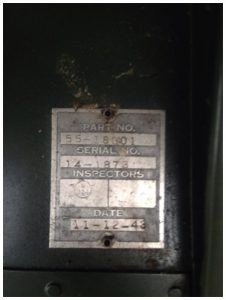 Something else recently came to light when Brian Jones noticed a serial numbered plate on the inside of the port flap with the date of 11-12-1943….Initially, this was quite exciting as we knew this could easily be traced. Using our Facebook friends, we asked if anyone could throw some light on this and Shane Clayton from Canada came back with the following information….
Something else recently came to light when Brian Jones noticed a serial numbered plate on the inside of the port flap with the date of 11-12-1943….Initially, this was quite exciting as we knew this could easily be traced. Using our Facebook friends, we asked if anyone could throw some light on this and Shane Clayton from Canada came back with the following information….
Shane Clayton The ’14-‘ on the serial number means that it came from the Lend-Lease batch of Noorduyn AT-16’s (i.e. all the FE***, FH***, FS***, FT***, KF***, etc. Harvard Mk IIB’s). So 14A-1873 was KF172, but I don’t know if it was actually fitted to KF172 and installed on your Harvard later or as part of the vast spares inventory left at Noorduyn after the war and was eventually installed on your Harvard during production. I’m leaning towards it being installed on KF172 first, as your Harvard was built mid-way through the Can-Car production run (292 out of 555) and most likely would have had 99% CC&F new-built parts by that point in production.
So what Happened to KF172? – Martin Pengelly states – im afraid it didn’t do much… in storage most of its life and then issued to the Central Flying School between February 1951 and January 1955. Was sold for scrap in April 1957.
Rear Wing Spar Plate:
 So this was slightly disappointing as we had hoped in a jovial sort of way that it might have come off a Harvard that had been operational in some exotic wartime location like the middle east or Malta training Hurricane pilots; however, this was not to be the case. KF 172 lived a very short existence, probably assisted in its 4 years of service life in the training of hundreds of pilots before succumbing to the blow torch and cutters!
So this was slightly disappointing as we had hoped in a jovial sort of way that it might have come off a Harvard that had been operational in some exotic wartime location like the middle east or Malta training Hurricane pilots; however, this was not to be the case. KF 172 lived a very short existence, probably assisted in its 4 years of service life in the training of hundreds of pilots before succumbing to the blow torch and cutters!
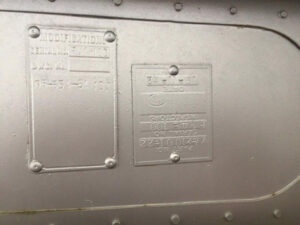
Shane Clayton – Looks like these came off an RCAF Mk 4 since BJST was already in Italy by 1959. Aircraft Industries was the overhaul depot for eastern Canada. (Northwest Industries in Edmonton was for western Canada)
Shane Clayton, I’m pretty certain that the mod plate refers to the diagonal stringer reinforcements added to RCAF Harvard’s undersides (both 2 & 4) horizontal stabilizers in the mid to late fifties.
Let me introduce the Wacky Wabbit and AJ841
 13th May 2015 – paint is thoroughly wiped off with thinners, it’s a messy job, but someone has to do it. 05/06/2015 – ST looking extremely naked! The lads Richard and Sam of RS painters have done an amazing job. They even stayed overnight at the airfield to get in early to turn on the heating. As you can see, the acid “The secret weapon” (FAA CAA approved) has totally stripped the aircraft down to the bare metal. The underside will be stripped tomorrow.
13th May 2015 – paint is thoroughly wiped off with thinners, it’s a messy job, but someone has to do it. 05/06/2015 – ST looking extremely naked! The lads Richard and Sam of RS painters have done an amazing job. They even stayed overnight at the airfield to get in early to turn on the heating. As you can see, the acid “The secret weapon” (FAA CAA approved) has totally stripped the aircraft down to the bare metal. The underside will be stripped tomorrow.
05/06/2015 – When Richard and Sam said they would do a bare-metal repaint, they were not wrong! As you can see, this is down to the bare metal, not a spec of paint in sight…The whole aircraft will be in this condition before being carefully prepared and primed.

08/06/2015 – Almost completely stripped and ready for the jet wash. The underside is nearly stripped, just the inboard section of the wing to strip and the walkway cleaned off, ready for the new 3M covering.
10/06/2015 – After a couple of weeks of being enclosed in the paint booth with the muck and fumes of the paint stripper, it was time to get some fresh air for the aircraft and the team. Out in the sun, the aircraft was pressure washed and cleaned. The acid residue was removed and prepared, ready for the next phase, sanding the whole airframe down. Only minor corrosion was found, which will need some minor attention before the aircraft is ready for priming.
16/06/2015 – The wing has been completely stripped and sanded.

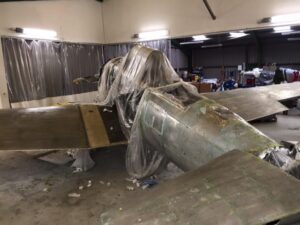



15th March 2021 – The Wabbit has smoke!
I (Andy) personally wanted smoke from the day that I started my display authorisation; however, this wasn’t easy to do in a syndicate of 4 people as I was outvoted! Things changed when the syndicate changes to just Brian and Andy then we decided to have the system fitted. This wasn’t an easy thing to do as I have to get the CAA minor mod approved that cost over £1000 just for the paperwork and then a further £1500 for the smoke system and a further £2000 plus in labour etc., get the system fully plumbed in. This wasn’t counting the £500 for the barrel of smoke oil from Transair! The bottom line is that the whole exercise was worth every penny as the beautiful Wacky Wabbit not only sounds good but, with the added value of the smoke system, is visually pleasing to the spectators at the air shows.
 The smoke system looks perfect and is an epic event in the Wacky Wabbit’s history – Today, 15th March 2021, the smoke system for the first time during the Wabbits Anual and great success! The smoke system will enhance the display with the Wabbit. We look forward to showing her off at as many displays as possible!
The smoke system looks perfect and is an epic event in the Wacky Wabbit’s history – Today, 15th March 2021, the smoke system for the first time during the Wabbits Anual and great success! The smoke system will enhance the display with the Wabbit. We look forward to showing her off at as many displays as possible!
The work was carried out by the Aircraft Restoration Company ARC at Duxford and comprised of the smoke system purchased from the USA from Smoking Airplanes. We opted for the twin nozzle for maximum smoke effect!
Below Is the smoke tank fitted into the Wabbit and the extra wall incorporated as a safety measure.


SMOKE ON FOR A SUCCESSFUL 2021
D-DAY June 6th 2021 Wabbit arrives at ARC for the new engine
End of an era!
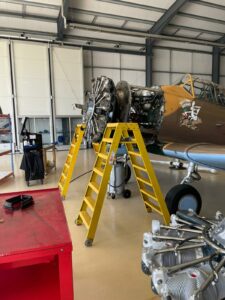 I shall add to this as the engine is installed, so it’s an ongoing blog:
I shall add to this as the engine is installed, so it’s an ongoing blog:
The R-1340 Radial: Classified as a top-secret design when it was developed in the 1920s, the R-1340 engine is still as much of a modern marvel today as it was almost 100 years ago, making it one of the aviation industry’s modern marvels.
The end of an era: Finally, the time has come to change the wonderful Covington R1340 radial on the Wacky Wabbit Harvard 4 G-BJST, which has been a part of her since we purchased her 2010. Although, on a personal note, I’m sorry to see this engine go, as it’s really just a teenager and not quite an adult yet!
It has bedded itself beautifully over the past 1100 hours, which has instilled confidence in its reliability with all that have flown in her, pilot and passenger alike. I have personally sat behind this engine for over 400 hours. I have had great faith in its reliability and robustness, having worked G-BJST hard on very demanding airshow routines over the past 10 years. Most of my flights have only been 20 mins maximum, so I have personally flown over 1000 individual sorties without so much as a cough from this engine. The engine has started perfectly on the fourth blade every time with 5 primes from cold and only two when warm as the Ts and Ps settle and stabilise quickly.
So why change it?
 Right: The Wabbit so resplendent in her new Cambai covers freshly re weatherproofed and refurbished 6th June 2021.
Right: The Wabbit so resplendent in her new Cambai covers freshly re weatherproofed and refurbished 6th June 2021.
As a company T6 Harvard Ltd, we have operated this engine perfectly as the condition shows after 1100 hours of hard operation. So what’s the secret? I would say the secret is that we operate it exactly how the book tells you to operate it!
As we begin the engine change, It has to be noted that the compression on the soon to be replaced engine was 80/80, the same as a new engine and hardly used any oil. However, the CAA and the powers that state that as we operate on the public transport register on a Certificate of Airworthiness, we must change the engine at 1000 hours as a Company that does Trial lessons. Curious why the CAA chose that number of hours. P&W never published a TBO for the R-1340, and the closest I’ve seen to a TBO official document is in RCAF EO-05-55A-7A, where they recommend the engine be replaced 1400 hours. But that’s another story to be discussed later on! The CAA was generous enough to extend the engine to 1100. It is such an ‘Honest’ and well-maintained engine with excellent documentation and serviced on the correct hours by the highly reputable “Aircraft Restoration Company” ARCo Duxford England. We were lucky, I guess, to get an extension to the engine as it was so well maintained and in such great condition from 1000 to 1100 hours.
 Which engine to purchase and where from:
Which engine to purchase and where from:
We had plenty of options to choose from, and the two top names kept on coming up were Covington engines and Tulsa engines, both refurbished in the USA; both have fantastic reputations, so I was torn between the two; however, ARCo our Continuing Airworthiness Management Organisation (CAMO) gave me the solution to the problem as they had a Zero timed Covington engine sat in a crate on the shelf… So, lucky for us, we negotiated a great deal with ARCo, and the rest shall be history!
When purchasing or exchanging a Radial engine in the UK, the biggest problem is purchasing what is a relatively cheap engine (Compared to a Merlin and actually comparative to a Gypsy Major) back to the UK from the USA. Once you have put the engine in a suitable crate in the USA, insured it and sent it to the UK, the buyer in the UK would get hit with the unknown import duty and other stealth, British taxes, which would now turn the purchase into a very costly engine! So there’s a good opening in the UK for a radial engine shop that can recondition these engines to the highest standards whilst remaining competitively priced.
Fitting the engine:
Having been involved with the “Wacky Wabbit” Harvard since 2010 when we had a syndicate of four, I followed the maintenance closely; however, when the syndicate reduced to just the two of us, I knew that on the next engine change, there would be parts that would need to be replaced when we installed the new engine and only the two of us to bear the brunt of the cost. It seemed false economy to ignore parts that were almost at the end of life that would ultimately need changing in the future. So 12 months before the engine change, I started to collect parts. I purchased NOS Engine Baffles, the back end exhaust system, Magneto cooling tubes, and the hoses remade ready for installation. The total cost of all of these parts in 2021 cost around £5000; however, I knew that all the weak links that may go wrong in the future had been addressed when we installed the engine.
The Wabbit arrives at ARCo:
On the 6th June 2021 D-Day, the wabbit had a very successful day at Old Warden, which was the last day flying on the old engine. We had almost timed it to perfection as the Wabbit arrived back at Duxford with only 2.5 hours left on the engine until it hit the 1100 hours. As it was a shame to lose the last 2.5 hours, we managed to fly an hour off before parking it at ARCo for the evening.
9th June 2021
As you can see, ARC0 have been busy removing the beloved old R1340 Radial, so now comes the job of removing all the parts off the old engine and fitting them to the new engine along with all the new replacement parts. As you can see, ARCo took all the pictures below on the same day! ARCo managed to remove the old engine and refit all the necessary parts to the new engine and for the engine onto the Wabbit all in one day! Impressive work, chaps! Now the guys have to remake and fit all the hoses etc.

